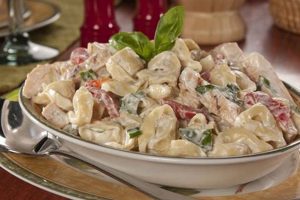A dish featuring cooked chicken, typically shredded or diced, combined with pesto and other ingredients to create a flavorful salad. Common additions include mayonnaise, vegetables like celery or red onion, and sometimes fruits like grapes or dried cranberries. This versatile dish can be served as a sandwich filling, on crackers, lettuce cups, or enjoyed as a standalone salad.
This combination offers a fresh and vibrant alternative to traditional chicken salad, introducing the bright, herbaceous flavors of pesto, which traditionally includes basil, pine nuts, garlic, Parmesan cheese, and olive oil. The pesto adds depth and complexity, elevating the flavor profile beyond simple mayonnaise-based salads. Its adaptability to various dietary needs and preferences through ingredient substitutions further contributes to its appeal. Furthermore, the relative ease and speed of preparation make it a practical choice for a quick meal, lunch, or potluck contribution.
Further exploration will delve into specific ingredient variations, preparation techniques, and serving suggestions, offering a comprehensive guide to crafting and enjoying this culinary creation.
Tips for Creating Exceptional Chicken Salad with Pesto
Optimizing a chicken salad featuring pesto requires attention to ingredient selection and preparation techniques. The following tips offer guidance for achieving superior results.
Tip 1: Chicken Selection and Preparation: Employing high-quality, properly cooked chicken contributes significantly to the overall quality. Roasting or grilling the chicken enhances flavor compared to boiling. Allowing the chicken to cool completely before shredding or dicing prevents a mushy texture.
Tip 2: Pesto Quality and Freshness: Utilizing fresh, high-quality pesto yields optimal flavor. Store-bought pesto can be a convenient option, but homemade pesto allows for customization and control over ingredients.
Tip 3: Balancing Flavors: Mayonnaise acts as a binder and adds creaminess, but excessive amounts can mask the pesto’s flavor. Start with a smaller quantity and adjust according to preference.
Tip 4: Incorporating Complementary Ingredients: Enhancements such as toasted pine nuts, sun-dried tomatoes, or artichoke hearts add texture and complexity. Consider incorporating finely diced red onion or celery for a contrasting crunch.
Tip 5: Seasoning and Adjustment: Tasting and adjusting seasonings throughout the preparation process is crucial. Freshly ground black pepper and a touch of salt can elevate the overall flavor profile. A squeeze of lemon juice can brighten the dish.
Tip 6: Chilling and Serving: Chilling the salad for at least 30 minutes allows the flavors to meld. Serve chilled on bread, crackers, lettuce cups, or as a standalone salad.
Tip 7: Ingredient Substitutions: This recipe adapts well to dietary preferences. Greek yogurt or avocado can replace mayonnaise for a healthier option. Substitute walnuts or almonds for pine nuts. Vary the herbs within the pesto for a different flavor profile.
Attention to these details elevates the final product, ensuring a flavorful and satisfying culinary experience.
By incorporating these tips, one can consistently create a chicken salad with pesto that is both delicious and visually appealing. The following section offers concluding remarks and serving suggestions.
1. High-quality Chicken
High-quality chicken plays a pivotal role in the overall success of a chicken salad pesto recipe. The chicken provides the foundational protein and texture, significantly influencing the final dish’s flavor and enjoyment. Utilizing superior chicken results in a more palatable and satisfying culinary experience. Conversely, employing lower-quality chicken can negatively impact the taste, texture, and overall appeal. The inherent flavor of the chicken interacts directly with the pesto, mayonnaise, and other ingredients. A bland or less flavorful chicken diminishes the impact of the other components, potentially resulting in a less vibrant and enjoyable salad.
Several factors contribute to chicken quality. These include the chicken’s breed, diet, and freshness. Free-range or organically raised chickens often exhibit a richer, more pronounced flavor compared to conventionally raised birds. Freshness also plays a crucial role; recently cooked or freshly purchased chicken provides the best flavor and texture. For instance, using roasted chicken from a local butcher shop, known for its quality sourcing, will likely yield a more flavorful salad than using pre-cooked, packaged chicken. Similarly, utilizing leftover grilled chicken from a previous meal adds a subtle smoky note that complements the pesto. Understanding these nuances empowers informed decisions regarding ingredient selection, optimizing the potential of the chicken salad pesto recipe.
In conclusion, the quality of chicken directly correlates with the final quality of the chicken salad pesto recipe. Prioritizing high-quality chicken ensures a richer, more flavorful, and ultimately more enjoyable culinary outcome. Recognizing the impact of chicken quality allows for informed ingredient choices, maximizing the potential of this versatile dish. It sets the stage for a successful and satisfying culinary creation.
2. Fresh Pesto
Fresh pesto significantly impacts the overall quality of a chicken salad pesto recipe. The pesto’s vibrancy and flavor profile directly influence the final dish. Freshly made pesto, characterized by bright green color and robust aroma, imparts a distinct herbal complexity. This freshness contrasts starkly with pre-made or preserved pesto, which can sometimes exhibit muted flavors or oxidized, darkened hues. The difference stems from the volatile oils present in basil, a primary pesto ingredient. These oils degrade over time, particularly with exposure to air and light, leading to flavor loss.
The practical implications of using fresh pesto are substantial. A chicken salad featuring fresh pesto offers a brighter, more pronounced flavor profile, highlighting the basil’s herbaceous notes alongside garlic, pine nuts, and Parmesan cheese. This vibrancy elevates the entire dish, creating a more dynamic and satisfying sensory experience. For instance, freshly made pesto, incorporating high-quality olive oil and freshly grated Parmesan, contributes a richer, more nuanced flavor compared to a pre-made version using processed cheese and lower-grade oil. Conversely, using older pesto can result in a flatter, less vibrant salad, potentially requiring additional seasoning or ingredients to compensate for the diminished flavor. Furthermore, the texture of fresh pesto contributes a desirable element to the chicken salad. Its slightly coarse consistency adds a pleasant counterpoint to the smoothness of the chicken and mayonnaise.
In summary, prioritizing fresh pesto is paramount for maximizing the flavor and overall quality of a chicken salad pesto recipe. The enhanced brightness, depth of flavor, and textural contribution of fresh pesto elevate the culinary experience. Recognizing the connection between pesto freshness and final dish quality allows for informed decision-making, ensuring optimal flavor and enjoyment. This understanding empowers one to create a chicken salad that truly showcases the vibrant potential of this classic combination.
3. Balanced Flavors
Balanced flavors are crucial for a successful chicken salad pesto recipe. The inherent richness of pesto, derived from basil, garlic, pine nuts, and Parmesan cheese, requires careful balancing with other ingredients to avoid an overpowering or one-dimensional taste. Harmonizing these flavors creates a more nuanced and enjoyable culinary experience.
- Salt and Acidity
Salt enhances the pesto’s savory notes and balances the richness of the other ingredients. Acidity, often from lemon juice or vinegar, brightens the flavors and cuts through the richness of the mayonnaise and pesto, preventing the salad from feeling heavy. A touch of salt amplifies the inherent flavors of the pesto, while a squeeze of lemon juice adds a refreshing counterpoint. The interplay between these elements prevents the dish from becoming overly rich or bland.
- Creaminess and Texture
Mayonnaise contributes creaminess and binds the ingredients, but its quantity requires careful consideration. Too much mayonnaise can overwhelm the pesto’s flavor, while too little can result in a dry salad. Textural elements, like toasted pine nuts or chopped celery, offer a contrasting crunch, adding complexity to each bite. The smooth creaminess of the mayonnaise complements the slight coarseness of the pesto, while the added crunch of toasted pine nuts provides textural contrast.
- Aromatic Complexity
The aromatic intensity of pesto can be further enhanced by incorporating complementary herbs and spices. A pinch of red pepper flakes adds a subtle heat, while fresh parsley or chives contribute a fresh, herbaceous element. These additions create a more complex flavor profile, elevating the overall experience. For instance, the peppery bite of red pepper flakes complements the basil’s herbaceousness, adding depth to the flavor profile. Similarly, a sprinkle of dried oregano can enhance the pesto’s inherent earthiness.
- Sweetness and Savory Notes
A touch of sweetness can balance the savory notes of the pesto and other ingredients. Incorporating finely diced grapes or dried cranberries introduces a subtle sweetness that complements the savory elements, creating a more rounded flavor profile. The sweetness of dried cranberries, for example, provides a pleasant contrast to the savory pesto and chicken, adding another layer of complexity to the overall flavor profile. This interplay prevents the dish from becoming overly savory or one-dimensional.
Achieving balanced flavors involves a thoughtful approach to ingredient selection and proportion. The interplay of salt, acidity, creaminess, texture, aromatics, and sweetness determines the final flavor profile of the chicken salad. By carefully balancing these elements, one creates a harmonious and enjoyable culinary experience that highlights the pesto’s vibrant character while ensuring a well-rounded and satisfying dish.
4. Textural Variety
Textural variety plays a crucial role in the overall enjoyment of a chicken salad pesto recipe. A combination of textures elevates the sensory experience beyond the simple interplay of flavors. The interplay of contrasting textures creates a dynamic and engaging mouthfeel, adding depth and complexity to each bite. Understanding how different textural elements contribute to the final product allows for a more informed and nuanced approach to recipe development and preparation.
- Chicken Texture
The chicken’s texture provides a foundational element. Shredded chicken offers a finer, more delicate texture, while diced chicken presents a more substantial, chewier presence. The choice between these options influences the overall mouthfeel of the salad. For instance, shredded chicken absorbs the pesto and mayonnaise more readily, creating a smoother, more cohesive texture, while diced chicken provides more distinct, separate pieces within the salad.
- Pesto Consistency
Pesto, typically made with a mortar and pestle or food processor, contributes its own textural element. A coarser pesto, with discernible pieces of basil, garlic, and pine nuts, introduces a pleasant roughness, contrasting with smoother elements. A finer pesto offers a more uniform, less textured experience. The consistency of the pesto interacts with the other ingredients, influencing the overall textural profile of the salad.
- Added Ingredients
Incorporating additional ingredients contributes further textural complexity. Toasted pine nuts offer a satisfying crunch, while chopped celery or red onion introduces a crisp, refreshing element. Sun-dried tomatoes contribute a chewy texture, further diversifying the mouthfeel. These additions create points of interest within each bite, enhancing the overall dining experience.
- Bread or Cracker Choice
When served as a sandwich filling or with crackers, the choice of bread or cracker introduces another layer of textural consideration. Crusty bread offers a robust contrast to the softer salad, while delicate crackers provide a less assertive textural counterpoint. The interplay between the salad’s texture and the accompanying bread or cracker influences the overall perception of the dish.
The careful consideration of textural variety elevates the chicken salad pesto recipe from a simple combination of ingredients to a multi-sensory culinary experience. The interplay of different textures creates a dynamic and engaging mouthfeel, adding depth and complexity to each bite. Understanding these elements allows for a more nuanced approach to preparation, ensuring a truly satisfying and enjoyable culinary creation.
5. Proper Seasoning
Proper seasoning is essential for maximizing the flavor potential of a chicken salad pesto recipe. While pesto inherently contributes a robust flavor profile, careful seasoning enhances and balances the overall taste, preventing the dish from becoming bland or one-dimensional. Seasoning elevates the inherent flavors of the ingredients, creating a more harmonious and satisfying culinary experience. It is not merely an afterthought but a crucial step that significantly impacts the final product.
- Salt’s Role
Salt amplifies the existing flavors of the chicken, pesto, and other ingredients. It acts as a flavor enhancer, bringing out the nuances of the basil, garlic, and Parmesan cheese in the pesto. Using too little salt results in a bland salad, while excessive salt overpowers the other flavors. The correct amount of salt elevates the overall taste profile without dominating it. Kosher salt, due to its larger crystal size, allows for more controlled seasoning.
- Black Pepper’s Contribution
Freshly ground black pepper adds a layer of complexity and depth. Its subtle heat and pungent aroma complement the pesto’s herbaceous notes. Pre-ground pepper often lacks the vibrancy and intensity of freshly ground peppercorns. The act of grinding releases volatile oils, maximizing the pepper’s impact on the final dish. A few twists of a pepper mill add a noticeable lift to the overall flavor profile.
- Acidity’s Balancing Effect
A touch of acidity, often from lemon juice or vinegar, brightens the flavors and cuts through the richness of the mayonnaise and pesto. It provides a necessary counterpoint to the richness of the other ingredients, preventing the salad from feeling heavy. A squeeze of lemon juice adds a refreshing brightness and balances the richness of the pesto and mayonnaise. This acidity enhances the overall flavor profile and prevents the dish from becoming cloying.
- Balancing Flavors
The key to proper seasoning lies in achieving balance. The goal is not to mask the flavor of the pesto but to enhance and complement it. Start with a small amount of each seasoning and taste frequently, adjusting as needed. The interplay of salt, pepper, and acidity creates a harmonious flavor profile that highlights the pesto’s vibrant character while ensuring a well-rounded and satisfying dish. Over-seasoning can be difficult to correct, so a cautious approach is recommended.
Proper seasoning elevates the chicken salad pesto recipe from a simple combination of ingredients to a well-balanced and flavorful dish. Attention to these details ensures that the final product showcases the best of each ingredient, creating a satisfying and enjoyable culinary experience. The careful application of seasonings transforms the dish, maximizing its potential and highlighting the harmonious interplay of flavors.
6. Sufficient Chilling
Sufficient chilling is a crucial step in preparing a chicken salad pesto recipe, significantly impacting the final dish’s flavor and overall quality. Chilling allows the flavors of the various ingredientschicken, pesto, mayonnaise, and any additional componentsto meld and harmonize, resulting in a more cohesive and complex flavor profile. This process enhances the overall culinary experience, transforming a simple mixture into a well-integrated and flavorful salad.
- Flavor Development
Chilling allows the individual flavors of the ingredients to meld and mature. The pesto’s herbaceous notes, the chicken’s savory character, and the mayonnaise’s richness combine more thoroughly during the chilling process. This fusion creates a more balanced and nuanced flavor profile than a freshly made, unchilled salad. The flavors become more integrated and harmonious, enhancing the overall taste experience.
- Texture Enhancement
Chilling firms the chicken and stabilizes the mayonnaise, contributing to a more desirable texture. A chilled salad holds its shape better, making it ideal for sandwiches or presentations on crackers or lettuce cups. The chilling process also allows the other ingredients, such as chopped vegetables or toasted nuts, to maintain their textural integrity within the salad. This contributes to a more satisfying and enjoyable mouthfeel.
- Food Safety
Chilling is essential for food safety, particularly with mayonnaise-based salads. Maintaining a low temperature inhibits bacterial growth, reducing the risk of foodborne illness. Proper chilling ensures the salad remains safe for consumption, especially crucial during warmer weather or when preparing the salad in advance. Adhering to food safety guidelines is paramount for protecting consumer health.
- Enhanced Sensory Experience
A chilled chicken salad pesto recipe offers a more refreshing and enjoyable sensory experience, particularly during warmer months. The cool temperature enhances the perception of flavors and provides a welcome contrast to the ambient temperature. This heightened sensory experience contributes to the overall enjoyment of the dish.
Sufficient chilling is an essential step that elevates the chicken salad pesto recipe from a simple mixture to a well-integrated and flavorful dish. The melding of flavors, texture enhancement, and food safety considerations underscore the importance of this often-overlooked step. By allowing sufficient chilling time, one ensures a more satisfying and enjoyable culinary experience, showcasing the full potential of this versatile and flavorful salad.
7. Versatile Serving
Serving versatility significantly contributes to the appeal of a chicken salad pesto recipe. Its adaptability to various presentations expands its utility beyond a single serving style, enhancing its suitability for diverse occasions and preferences. This adaptability increases the recipe’s overall value, making it a practical and convenient choice for a range of culinary needs.
- Sandwiches
Chicken salad with pesto functions effectively as a sandwich filling. Its flavor profile complements various bread types, from crusty sourdough to soft whole wheat. The salad’s texture provides a satisfying contrast to the bread, creating a balanced and enjoyable sandwich experience. Additions like lettuce, tomato, or sprouts further enhance the sandwich’s textural and flavor complexity. This application makes the recipe suitable for quick lunches, picnics, or casual meals.
- Crackers and Wraps
Serving the salad with crackers or in wraps offers a lighter alternative to sandwiches. The crispness of crackers provides a textural counterpoint to the creamy salad. Wraps, whether using traditional tortillas or lettuce cups, offer a convenient and portable serving method, ideal for snacks, appetizers, or light meals. This versatility allows for portion control and caters to different dietary preferences.
- Salads and Bowls
The chicken salad can serve as a component within larger salads or grain bowls. Combining it with mixed greens, other vegetables, and a light vinaigrette creates a complete and balanced meal. This approach offers a refreshing and customizable option, catering to individual preferences and dietary needs. Incorporating quinoa or brown rice adds a nutritious and texturally diverse element to the bowl.
- Appetizers and Snacks
The adaptability of chicken salad with pesto extends to appetizers and snacks. Serving small portions on endive leaves, cucumber slices, or toasted baguette rounds provides elegant and flavorful finger foods suitable for parties or gatherings. These bite-sized portions offer a convenient and appealing way to showcase the recipe’s versatility. Such presentations enhance the visual appeal and make the dish suitable for more formal occasions.
The versatility of chicken salad with pesto enhances its appeal as a practical and adaptable recipe. Its suitability for sandwiches, crackers, wraps, salads, and appetizers makes it a valuable addition to any culinary repertoire. This adaptability caters to a wide range of occasions and preferences, maximizing its utility and solidifying its place as a versatile and convenient culinary choice. From casual lunches to elegant appetizers, the chicken salad with pesto recipe proves its adaptability and enduring appeal.
Frequently Asked Questions
This section addresses common inquiries regarding chicken salad prepared with pesto, providing concise and informative responses.
Question 1: What type of chicken works best in this recipe?
Rotisserie chicken offers convenience, while freshly roasted or grilled chicken maximizes flavor. Boiling is less desirable as it can dilute the chicken’s flavor.
Question 2: Can store-bought pesto be used?
Store-bought pesto is acceptable; however, freshly made pesto typically offers a more vibrant flavor profile.
Question 3: How long can the salad be stored?
Properly stored in an airtight container in the refrigerator, the salad should be consumed within three to four days.
Question 4: What can be substituted for mayonnaise?
Greek yogurt or avocado provide healthier alternatives to mayonnaise, offering similar creaminess with different flavor profiles.
Question 5: Can this salad be frozen?
Freezing is not recommended as it can negatively impact the texture of the mayonnaise and other ingredients.
Question 6: How can the nutritional value be increased?
Adding ingredients like chopped vegetables (e.g., bell peppers, celery, cucumber) or legumes (e.g., chickpeas, cannellini beans) enhances nutritional content.
Understanding these aspects allows for informed choices in preparation and consumption, maximizing enjoyment and ensuring a safe and flavorful culinary experience.
This concludes the frequently asked questions section. The following section will provide a complete recipe with detailed instructions.
Chicken Salad Pesto Recipe
Exploration of this culinary combination reveals the interplay of key elements contributing to its success. Ingredient quality, specifically the chicken and pesto, forms the foundation. Freshly prepared pesto maximizes flavor intensity. Balancing the pesto’s richness with other components, such as mayonnaise, ensures a harmonious flavor profile. Textural variety, achieved through additions like toasted pine nuts or chopped vegetables, elevates the sensory experience. Proper seasoning and sufficient chilling time optimize flavor development and food safety. Finally, the recipe’s adaptability to various serving styles, from sandwiches to salads, underscores its versatility.
Careful consideration of these factors elevates the chicken salad pesto recipe beyond a simple combination of ingredients. This understanding empowers culinary exploration and personalized adaptations, ensuring a consistently satisfying and enjoyable gastronomic experience. The potential for creative variations, incorporating diverse ingredients and presentations, positions this recipe as a versatile and enduring culinary classic.






